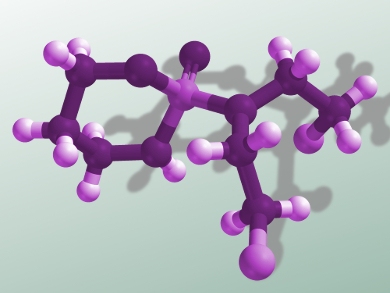A Stand-In for DNA
Tests and assays for cancer-causing, carcinogenic, mutagenic and toxic compounds abound. They are usually quite time consuming, technically demanding, and require expensive equipment and facilities to obtain results that comply with regulations and are, more to the point, scientifically valid.
The compound 4-(4-nitrobenzyl)pyridine (NBP), which shares structural and reactivity features with guanine, one of the four nucleobases in DNA, has been used for some time as a straightforward colorimetric indicator for many types of alkylating agents. Indeed, NBP can substitute for DNA, acting as a proxy for the biological macromolecule in a wide range of testing environments from toxicological screening of putative pharmaceutical agents to the detection of chemical weapons, from environmental hygiene technology to the exploration of mutagenicity in drugs, as well as for other chemical analyses.
Alkylating Agents – Both Useful and Dangerous
Philip Provencher and Jennifer Love, University of British Columbia, Vancouver, Canada, point out that alkylating agents themselves are widely useful, as active pharmaceuticals, agrochemicals, industrial and laboratory reagents and solvents, and as chemical warfare agents. These compounds are highly toxic, mutagenic, and/or carcinogenic partly because they form strong covalent bonds with endogenous nucleophiles. Indeed, this is their mode of action in many instances, especially when the target is DNA or a protein, but that same activity is associated with toxicity and other problems. Given their widespread use in hospitals, it is not a surprise that healthcare staff in hospitals and industrial workers handling alkylating agents can be exposed to potentially hazardous levels, where skin penetration is a significant problem.
Provencher and Love explain that there is a need for a detector that has “turn-on” sensing, a biologically relevant detection limit, is not perturbed by Brønsted acids or polar solvents, and resists air oxidation and other degradation problems.
Improving on 4-(4-Nitrobenzyl)pyridine
Interesting as NBP is for toxicological screening and other assays, it does suffer from several drawbacks. First, it has low water solubility, secondly it lacks reactive oxygen sites, and thirdly, and importantly with regard to its use as model of DNA, it has none of the steric encumbrance of the familiar double helix, being a simple, small molecule.
Provencher and Love have now explored NBP derivatives with a carbonyl group on the nitrobenzene ring that would make the compound behave more like guanine when exposed to alkylating drugs. From the basic skeleton, the team developed and successfully tested a range of NBP derivatives that might be incorporated into a simple sensor device. Trace detection of the common alkylating anticancer drug cyclophosphamide was used as proof of principle.
“We’re able to detect the presence of alkylating agents,” Love told ChemViews Magazine. “A number of alkylating agents are used to treat cancer chemotherapeutically and some are chemical warfare agents (such as the notorious mustard gas). Alkylating agents kill both cancer cells and healthy cells.” She adds that, “We have heard from pharmacists who handle cancer drugs that the ability to detect alkylating agents is important because they are so widely used.”
One particular derivative was especially effective at sensing alkylating agents in either solution or the solid state, the team reports. They explain that a sol-gel can be impregnated with the potassium salt of this compound to make a solid state sensor for use in hospitals and pharmacies. “Our next step is to determine the limits of detection and improve the response rate,” Love stated. “We are looking towards product development, as well.”
- Synthesis and Performance of a Biomimetic Indicator for Alkylating Agents,
Philip A. Provencher, Jennifer A. Love,
J. Org. Chem. 2015.
DOI: 10.1021/acs.joc.5b01584



